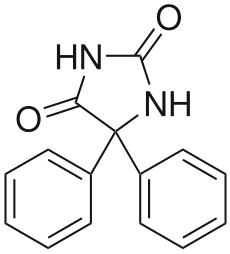Fetal hydantoin syndrome
| Fetal hydantoin syndrome | |
|---|---|
 | |
| Classification and external resources | |
| ICD-10 | Q86.1 |
| ICD-9 | 760.77 |
| OMIM | 132810 |
| DiseasesDB | 33179 |
Fetal hydantoin syndrome, also called fetal dilantin syndrome is a group of defects caused to the developing fetus by exposure to the teratogenic effects of phenytoin or carbamazepine. Dilantin is the brand name of the drug phenytoin sodium in the United States, commonly used in the treatment of epilepsy.
It may also be called congenital hydantoin syndrome,[1] Fetal Hydantoin Syndrome, Dilantin Embryopathy, or Phenytoin Embryopathy.
Association with EPHX1 has been suggested.[2]
Signs and symptoms
About one third of children whose mothers are taking this drug during pregnancy typically have intrauterine growth restriction with a small head and develop minor dysmorphic craniofacial features and limb defects including hypoplastic nails and distal phalanges (birth defects). A smaller population will have growth problems and developmental delay, or mental retardation. Methemoglobinemia is a rarely seen side effect.
Heart defects and cleft lip[3] may also be featured.
References
- ↑ Nicolai J, Vles JS, Aldenkamp AP (August 2008). "Neurodevelopmental delay in children exposed to antiepileptic drugs in utero: a critical review directed at structural study-bias". J. Neurol. Sci. 271 (1-2): 1–14. doi:10.1016/j.jns.2008.03.004. PMID 18479711.
- ↑ Online 'Mendelian Inheritance in Man' (OMIM) 132810
- ↑ Easton JD (December 1972). "Potential hazards of hydantoin use". Ann. Intern. Med. 77 (6): 998–9. doi:10.7326/0003-4819-77-6-998. PMID 4644176.
| ||||||||||||||||||||||||